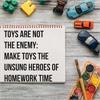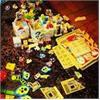by Michael Gibben
As an educator for nearly eleven years, one of the most common questions I have been asked by parents after learning sessions with their child is: “How do you keep my child so focused during learning?”
Sometimes this question is raised by parents who find homework time becomes an impromptu game of hide-and-go-seek (kids often hide from things they don’t want to do), or a mental tug of war, or a game of negotiation. If the reward for learning replaces bonding with their child and genuine rewards in learning, homework time will create a negative experience for both parent and child.
For elementary school children, the question of maintaining focus during learning can be summarized in five simple words: Toys are not the enemy.
Most of us can remember being told as children, “Finish your homework first or no play.” Or perhaps you recall being told, “Put that away! Turn that off! You have homework!”
The common misconception is that work and play are two separate states. To the contrary, there is much scientific evidence that learning through play leads to healthy gains in children.
The following are four steps, as told through one of the families that I mentor-tutor (Kim and her son Brice). Here is how Brice’s toys became the unsung heroes of homework time.
Step One
Toys: Distraction vs. Security
When I first met Brice, he was 7 years old and struggling with mathematics. Kim told me that Brice was nervous when learning something new. He would bring his Legos to the table during homework time. Kim would take the blocks away and remind Brice that he was there to work. Brice and Kim would then find 5 plus 2 had morphed into a battle of wills with little motivation and completion of work.
Brice, and children like him, will often bring their favourite toy(s) with them to the table as a form of security blanket. Kim’s first instinct was to take her son’s toy away out of concern that it was a distraction. However, this resulted in an increase in nervousness and less productivity from Brice.
Sitting with Brice and Kim, I asked Brice to set a spot for his Lego at the table. His Lego can have presence at the table. Brice’s tension eased when he saw that his toys were allowed to stay. Brice’s security blanket was accounted for, respected, and an optimal comfort zone for homework time was established.
Step Two
Toys: The Point of Connection
In our hectic world, there is a need to rush from task to task, from one checkpoint to the next. Homework is often viewed as one of these tasks.
Brice was very active in soccer, baseball, and swimming classes. He also had his friends and school. The rush to move from one venue to the next was on. As Kim and I discussed, it is okay to take a few minutes at the start of homework time to ask about your child’s toy(s). With Brice, his Lego was Star Wars Lego. The following prompts led to some light discussions:
- Why did you bring Yoda to our homework time today?
- What does Darth Vader think of your homework today?
A couple of light questions opened the door to Brice’s interests and thoughts on his homework (as told through his toys) and solidified a point of connection between his toys and his homework time.
These first two steps alleviate the tension regarding the start of homework and create easygoing dialogue. The next two steps will see your child use their toys to focus and engage in learning.
Step Three
Toys: The Learning Advantage
Kim and I looked at Brice’s math homework for the day and this was the first word problem:
- Bob has 4 apples and Sally has 5 apples, how many apples are there in total?
A generic question, and there were ten more questions that followed. You can take such generic questions and use the advantage of your child’s toys to create a customized question. With the change of a few words, Brice’s question became:
- Yoda has 4 lightsabers and Darth Vader has 5 lightsabers, how many lightsabers are there in total?
Kim then asked Brice to place Yoda and Darth Vader back onto the table and provided coloured toothpicks as lightsabers. Brice happily provided four green toothpicks to Yoda and five red toothpicks to Darth Vader. Brice counted the two groups and proudly stated nine. He then wrote his answer on the paper.
A 30-second adjustment led to the start of success rather than struggle.
Step Four
Toys: The Catalyst for Learning Progression
Now that Brice had a secure learning environment, engaging discussion with his mom, and was actively learning with his toys, they became the catalyst for additional learning.
With these four steps, Kim had transformed homework from being a source of headaches and hindrance into a source of ease and enrichment. Today, Brice is 9 years old and enjoys the third grade and all it has to offer.
Parents have asked Kim for her secret to Brice’s learning successes.
You may find that your child is not struggling in math but rather in reading. They may prefer Minecraft or Frozen to Lego Star Wars. Even with toys and your children at the table, there may be additional roadblocks. Not to worry, more strategies can be found in my upcoming e-book Toys are not the Enemy. Let’s inspire together!
Michael Gibben is an Ontario certified teacher and the owner of I.M. Success Tutoring. He has been an educator for eleven years and has coached thousands of parents and children to help guide success in confidence and academics. I.M. Success Tutoring develops customized mentor-tutoring programs for children ages 5–12. Contact Michael on Twitter or Facebook.
Michael’s e-Book Toys are not the Enemy will provide additional strategies, tips, and case studies for your child’s learning success. Toys are not the Enemy will be released in May 2016.
READ MORE LIKE THIS:
- How Your Kids Can Inspire You to be More Active
- 10 Tips for Creating a Smooth, Stress-Free Homework Routine
- 5 Ways to Engage Kids who “Hate” Reading
Keep informed with all our camps coverage and find the perfect camp by searching our Toronto & GTA camps directory.
Sign up for our newsletters to get parenting and family fun articles delivered to you!




